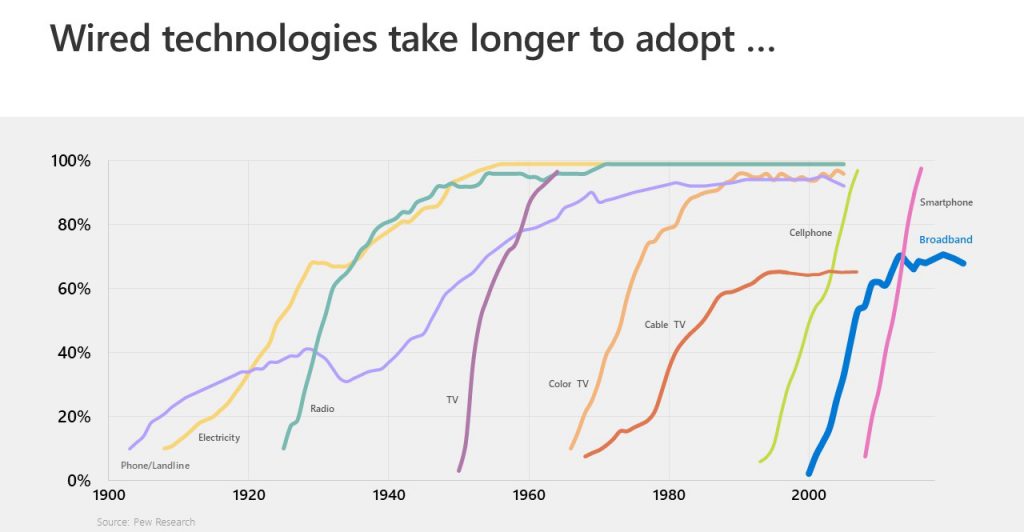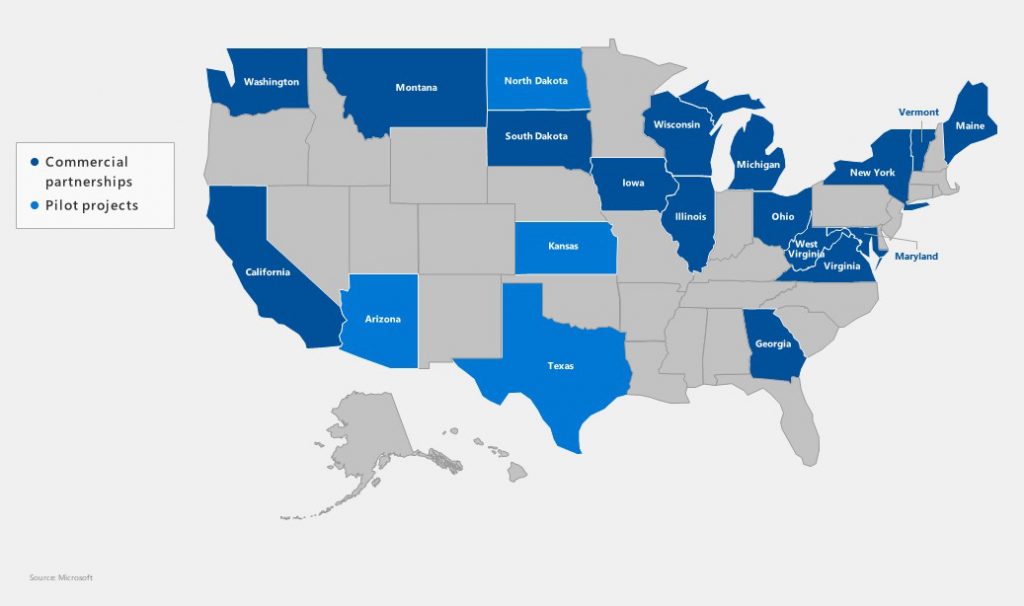Every day the world is becoming more digital. Cloud computing combined with new productivity, communication and intelligent tools and services enable us to do more, do it more quickly and in ways that were simply unimaginable a generation ago. But participating in this new era requires a high-speed broadband connection to the internet. While it’s a service that is as critical as a phone or electricity, according to the Federal Communications Commission (FCC) broadband is unavailable to roughly 25 million Americans, more than 19 million of which live in rural communities. That’s roughly the population of New York state.
Over the past five years, the FCC and the U.S. Department of Agriculture provided more than $22 billion in subsidies and grants to telecommunications carriers to sustain, extend and improve broadband in rural America. Despite these efforts, the country’s adoption of broadband hasn’t budged much since 2013. This inability to build out the last mile of the 21st century’s digital infrastructure has exacerbated the country’s growing prosperity and opportunity divides — divisions that often fall along urban and rural lines.
Without a proper broadband connection, these communities can’t start or run a modern business, access telemedicine, take an online class, digitally transform their farm or research a school project online. You see this dilemma play out in the U.S. Bureau of Labor Statistics employment data, which shows the highest unemployment rates are frequently located in the counties with the lowest availability of broadband. As a nation, we can’t afford to turn our backs on these communities as we head into the future.
The broadband gap is a solvable issue
At Microsoft we believe this is an urgent national problem that can and must be solved. In the summer of 2017 we called for a national effort and set an ambitious goal — to eliminate the country’s rural broadband gap by July 4, 2022. Closing the broadband gap will require a focused and comprehensive solution that combines private sector capital investment in innovative technologies with targeted financial and regulatory support from the public sector.
For the past 18 months we’ve contributed to this effort through our Microsoft Airband Initiative, a five-year commitment to bring broadband access to 2 million unserved Americans living in rural communities. During this time, we’ve accomplished and learned a lot.
First, we’ve learned that wireless technology can become the bridge that spans this broadband divide — a strategy supported by the adoption patterns for technologies since the early 1900s. Whether it be phone landlines, electricity, cable or broadband, wired technologies typically plateau at 70 percent penetration in the United States, before requiring decades of additional work and mountains of public money to close the remaining gap. For example, even after 25 years, electricity and cable TV hadn’t climbed above 70 percent.
In contrast, within 25 years the country achieved near-universal adoption of radio and color broadcast television, both of which obviously involved wireless technology. More recently, the pace of adoption for cellphones neared 100 percent in about 14 years and in just eight years for smartphones. Broadband adoption not only lags both of these technologies, but is slower than the adoption of radio, more than 70 years ago. This history of wired technology adoption doesn’t bode well for laying fiber optic cable to the distant reaches of our nation.
As the country looks to address 5G technology, it’s clear that it will provide a vital advance for many parts of the nation. But given the nature of the spectrum on which 5G relies, it’s not likely to soon reach the rural areas that currently lack broadband access. For example, today 13 percent of Americans using mobile devices still can’t even access 4G technology.
That’s why we continue to believe that TV white spaces technology can be a game changer for rural America. We’re confident that using a mixed model that combines wireless technologies including 4G and TV white spaces, traditional fiber-based connectivity, and satellite coverage can dramatically reduce the cost and time of extending broadband access to rural communities across America. Using this approach, we’ve already struck partnerships in 16 states that will bring broadband connectivity to more than 1 million rural residents who currently lack access.
Second, we’ve learned that effective partnerships with telecommunications providers and other groups can continue to accelerate this progress. It’s the small- and medium-sized companies in the very communities that we strive to connect who are closing the country’s broadband gap.

We see this entrepreneurial and innovative American spirit in an emerging TV white spaces ecosystem that has taken root. We are working with a consortium of component and device makers which are producing affordable, innovative TV white spaces technology for internet service providers (ISPs) and consumers. We are supporting ISPs by providing some funding for upfront capital costs for broadband infrastructure projects with the possibility of recovering our investment through revenue sharing. We then reinvest those funds in subsequent projects to further expand coverage.
When our Airband Initiative was launched 18 months ago, a TV white spaces network connectivity device cost more than $800. Today similar and even higher-quality, and more-capable devices cost less than $300. As the price of new technology falls and demand rises, these prices will continue to fall — a critical goal — and this market will become self-sustaining.
Once a community gains access to broadband, it’s again our partners, like the National 4-H Council and the National Future Farmers of America, who help to ensure that local people reap the rewards of connectivity through new digital skills. Through an extensive network of volunteers and professionals, these community nonprofits provide hands-on learning to help these communities participate and thrive in the digital economy.
And third, we’ve learned that an effective solution to this problem requires targeted but limited public sector help.
This needs to start with acquiring more accurate federal data to measure the problem. We can’t solve a problem that we don’t understand. There is strong evidence that the percentage of Americans without broadband access is much higher than the FCC’s numbers indicate. We’ve seen this over the past 17 months in many places and in many ways, including by talking directly to the people who live in rural America. Their real-world lack of broadband access differs sharply from the picture too often painted by inaccurate data in Washington, D.C.
In addition, the more we’ve examined alternative data sources, the more we’ve found additional reasons to doubt the federal government’s broadband data estimates. For example, the Pew Research Center has been tracking internet usage in this country since 2000 through regular surveys. According to their latest data, 35 percent of Americans report that they don’t use broadband at home — roughly 113 million people. While availability (estimated by the FCC) and usage (estimated by the FCC) are different, the significant gap between these two numbers raises important questions. It has led us to do more detailed work ourselves based on Microsoft’s data sources, with substantial review by our data scientists and analysts. Their work suggests that the Pew numbers are far closer to the mark. All of this leaves us with the inescapable conclusion that today there exists no accurate public estimate of broadband coverage in the United States.
But more positively, we are seeing new signs that help is on the way. We’re encouraged by the recent strides taken by the FCC toward collecting better data. While we have a way to go before we gain a full picture of the broadband problem, the agency has made it a priority to count and connect every community in our country.
Raising our ambition as a company, and a country
While we’ve made significant progress, we know there’s a lot more to do to bring broadband to every American. That’s why we are raising our ambition as a company and encourage the federal, state and local governments to do the same.
A year and a half ago, we announced that Microsoft’s Airband Initiative would bring broadband access to 2 million people by July 2022. Given our early progress, today we are raising our goal and increasing our commitment. We will pursue work to extend broadband access to 3 million Americans in rural areas by July 2022.
By this time next year, we will expand our Airband Initiative to reach 25 states. In these states we will both pursue Airband infrastructure projects and expand the work we are doing to offer skills training in rural communities. We will also continue to advocate for public policies to accelerate the investment in TV white spaces technologies that are needed.
As we deepen our commitment to bringing broadband to rural America, we believe the country can raise its ambition as well.
We think it’s time to look at how the country spends public money and retarget a small portion of those funds in ways that will close the broadband gap more quickly. To date, almost 90 percent of the money spent by the federal government on rural broadband has been spent on laying fixed lines, primarily fiber-optic cables — a solution that costs at least three to four times more than wireless technologies. We think there is a better way. If the federal government reallocates just a small additional fraction of public money toward incentives for TV white spaces devices, it will help accelerate adoption, bring costs of devices down and help the ecosystem lift off. None of this funding would go from the government to Microsoft, but it would be available to the telecommunications partners whom we are working to assist.
Moving faster will also require updating federal regulations governing the use of TV white spaces to free up this often unused and plentiful spectrum for rural broadband. Specifically, we are encouraged by the FCC prioritizing broadband and hope it will provide the regulatory certainty needed for rural America’s success.
Finally, this will continue to require expanding partnerships that will spur the economic growth and social equality that broadband can bring. These include new applications, solutions and ventures across the private sector to help boost yields and lower costs on farms, expand telemedicine to military veterans and turn local libraries into community hubs of digital learning.
And above all, this requires speed — internet speed. We all need to move faster. It took 50 years to electrify the nation. The millions of Americans waiting for broadband don’t have the luxury of time.
To learn more, read “An Update on Connecting Rural America: The 2018 Microsoft Airband Initiative.”

